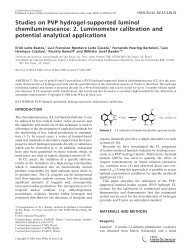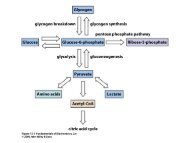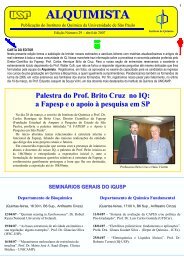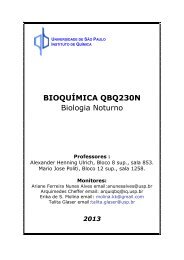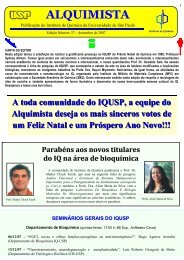Roberto TokoroONDAS CATALÍTICASPOLAROGRÁFICASO estudo do anion azoteto, N 3-, foi introduzidopor P. Senise 1 no <strong>Instituto</strong> <strong>de</strong> Química da <strong>USP</strong> em1955, alcançando a sua maior pujança com ostrabalhos <strong>de</strong> Neves 2 em 1966. Este foi o primeiro aobservar o processo catalítico polarográfico quandocations <strong>de</strong> Mn 2+ , Co 2+ e Zn 2+ estavam presentes notampão <strong>de</strong> azoteto (N 3-)/ácido azotídrico (HN 3). Talobservação resultou no trabalho <strong>de</strong> Tokoro 3 em 1977que vem <strong>de</strong>senvolvendo estudos <strong>de</strong> ondas catalíticaspolarográficas com os metais da primeira e segundafila <strong>de</strong> transição, bem como com os metais do grupoda platina 4-5 Estudos potenciometricos <strong>de</strong> complexos<strong>de</strong> Azoteto e Indio (III) 6 e <strong>de</strong>terminação da constante<strong>de</strong> solubilida<strong>de</strong> do AgN 3por espectrofotometria <strong>de</strong>absorção atômica 7 também foram <strong>de</strong>senvolvidos.A polarografia renasceu com vigor em 1990<strong>de</strong>vido à sua aplicação em sistemas químicoscombinados com catalisadores para <strong>de</strong>terminação <strong>de</strong>substancias orgânicas e inorgânicas, conformetrabalho <strong>de</strong> revisão <strong>de</strong> Stenger 8 . Nesse sentidoFungaro 9 <strong>de</strong>senvolveu trabalho sobre [Co(bipy) 3] 2+ /CHCl 3em DMF.A Educação química está sendo <strong>de</strong>senvolvidasobre aprendizagem centrada no aluno conformeCousinet 10 . Introduzir a disciplina <strong>de</strong> Metrologia emQuimica na gra<strong>de</strong> curricular no sentido <strong>de</strong> aprimorara formação do químico brasileiro 11 . A Universida<strong>de</strong>precisa rever a aprendizagem-ensino acadêmico, o<strong>de</strong>safio neste segundo milênio é continuarexecutando tudo que se tem feito, porém <strong>de</strong>senvolvernas pessoas a habilida<strong>de</strong> <strong>de</strong> julgar o valor e o valoragregado das coisas e do ser humano. Esta tarefa<strong>de</strong>ve ser um objetivo educacional mais imperativo 12 .A eletroanalitica do porvir seria o advento <strong>de</strong> sensor/reagente/catalisador seletivo a diferentes substâncias,associadas a várias técnicas analíticas, acopladas aosprocessadores e miniaturizados instrumentos. 13 Ésempre bom lembrar as palavras do Prof. West 14 :”osproblemas po<strong>de</strong>m variar, todavia a atitu<strong>de</strong> eprocedimento do ser humano analista não”Summary:Polarographic catalytic waves using azi<strong>de</strong>/hydrazoicacid buffer in the presence of metals of first andsecond transition roll as well the platinum groupmetals are being <strong>de</strong>veloped.Publicações:P.Senise,”Sôbre a reação entre ions <strong>de</strong> cobalto(II) e ion azoteto”, Faculda<strong>de</strong><strong>de</strong> Filosofia <strong>de</strong> Ciências e Letras da Universida<strong>de</strong> <strong>de</strong> São Paulo, São Paulo,1955 (Tese);E.F.ªNeves,”Estudos sôbre a reação entre ions azoteto e cations metálicosem meio aquoso”, Faculda<strong>de</strong> <strong>de</strong> Filosofia <strong>de</strong> Ciências e Letras da <strong>USP</strong>,1966 (Tese);R. Tokoro e E.F.A.Neves, J. Electroanal.Chem., 125, 115-128 (1981);M.Berttoti e R.Tokoro, J.Electroanal.Chem., 377, 287-289 (1994);C.Giovedi e R. Tokoro, J.Braz.Chem.Soc.,8, 187-191 (1997);M. Bertotti e R. Tokoro, Talanta, 36, 424 (1989);F.T.Braz, “Determinação da Constante <strong>de</strong> Solubilida<strong>de</strong> do AgN 3”,Dissertação <strong>de</strong> Mestrado <strong>de</strong>fendida no <strong>Instituto</strong> <strong>de</strong> Química da <strong>USP</strong>, SãoPaulo, <strong>2002</strong>;V.A Stenger et al., Anal.Chem., 57, I (1985) p.1;D.A Fungaro e R. Tokoro, J.Braz.Chem.Soc.,6, 23-27 (1995);R.Cousinet, Ä formação do educador e a pedagogia da aprendizagem”,Ed. Nacional, ED<strong>USP</strong>, São Paulo, SP, 1974;R. Tokoro et al., Proceeding of II Brazilian Congress of Metrology,Dec.2000, São Paulo, SP, Brazil;E. Lammert (Free University of Berlin), Discusses pronounced in the Instituteof Advanced Studies of University of Sào Paulo, São Paulo, SP, Brazil,1994;R. Tokoro, “Electroanalytical Trends”, capitulo do livro “Recent Developmentsand Application of Elesctroanalytical Chemistry”, Eds. HectorFernan<strong>de</strong>z and Maria Alicia Zon, Research Signpost, Kerala, India, <strong>2002</strong>;P.W.West, Anal.Chem. (1974) 46:9,78A.<strong>Instituto</strong> <strong>de</strong> Química - Pesquisa 2001 - <strong>2002</strong> 90 Departamento <strong>de</strong> Química Fundamental
Roberto Vicente SantelliBIOLOGIA MOLECULAR DERHYNCHOSCIARA AMERICANAA amplificação gênica e o estudo da origem <strong>de</strong>replicação do DNAA geração <strong>de</strong> muitas cópias <strong>de</strong> um gene, a amplificaçãogênica, po<strong>de</strong> se dar através <strong>de</strong> um processoque leve à justaposição das cópias em tan<strong>de</strong>m, oupor um outro mecanismo em que uma origem (zona)<strong>de</strong> replicação é reutilizada diversas vezes com aconseqüente formação <strong>de</strong> um gradiente <strong>de</strong>amplificação. A amplificação gênica dos genescoriônicos <strong>de</strong> Drosophila, e o processo semelhantepresente nos pufes <strong>de</strong> DNA das células politênicas<strong>de</strong> sciarí<strong>de</strong>os, por exemplo Rhynchosciara, encaixamseneste último mo<strong>de</strong>lo. Este processo é bizarro pelofato da permitir a reutilização <strong>de</strong> uma origem (ouzona) <strong>de</strong> replicação, em oposição ao que acontecena duplicação das células somáticas on<strong>de</strong> a origem éutilizada apenas uma vez e então bloqueada. Nestecaso isto garante que o DNA replicado resulte emdois genomas idênticos nas células filhas. O aspectointeressante é que aquele processo diferente pareceser conduzido pelos mesmos elementos regulatóriosatuantes na <strong>de</strong>finição e utilização <strong>de</strong> uma origem <strong>de</strong>replicação padrão, e po<strong>de</strong> ser utilizado como ummo<strong>de</strong>lo <strong>de</strong> estudo.ent organ (salivary gland), it becomes interesting to<strong>de</strong>fine and compare the basic molecular events ofthis bizarre subject. Initial work have i<strong>de</strong>ntified, inRhynchosciara and other sciaridae, the presence ofmessengers associated with the local amplification,its genomic resi<strong>de</strong>nce and patterns of expression andreplication. More <strong>de</strong>tailed knowledge is <strong>de</strong>pen<strong>de</strong>nton the application of mo<strong>de</strong>rn Molecular and CelularBiology tools, as has been intensively utilized in Drosophila.In this sense we start to i<strong>de</strong>ntify genes thatwould be implicated in the regulation of the amplification.Meanwhile we collaborate in two Genomeprojects sponsored by Fapesp to acquire expertise inthe broad field of genomic and its transference toour main research theme.Gene amplification in RhynchosciaraSummaryThe principal theme of research in our laboratoryis represented by the study of the so called DNA puffs,a cytological manifestation of the chromatin linkedto gene expression and local DNA amplification. Theyare present in the Sciaridae class of insects, particularlyin Rhynchosciara (Breuer & Pavan, 1955). Theunique counterpart of this phenomenon is observedin the follicle cells of the Drosophila ovary where occursthe amplification of the chorion genes. Due tothe interesting and unique occurrence of DNA amplificationin polytene chromosomes, and in a differ-Publicações:Santelli, RV & Siviero, F. A search for homologues of plant photoreceptorgenes and their partners in the sugarcane expressed sequence tag (Sucest)database. Genetics and Molecular Biology, 24: 49-53, 2001.Departamento <strong>de</strong> Química Bioquímica Fundamental91<strong>Instituto</strong> <strong>de</strong> Química - Pesquisa 2001 - <strong>2002</strong>



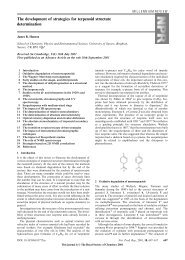
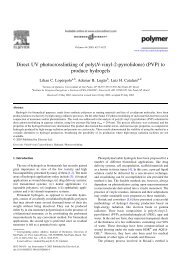
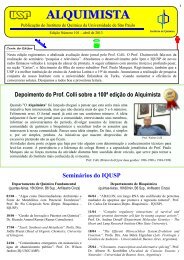
![PE]+ + N. Fragmentação por clivagem sigma](https://img.yumpu.com/50134385/1/180x260/pe-n-fragmentaaao-por-clivagem-sigma.jpg?quality=85)
